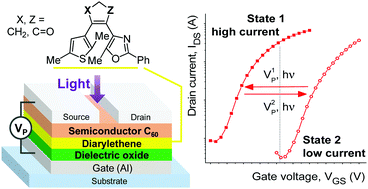Molecular structure–electrical performance relationship for OFET-based memory elements comprising unsymmetrical photochromic diarylethenes†
Abstract
A series of photochromic diarylethenes with different bridge moieties have been investigated as light-sensitive components of photoswitchable organic field-effect transistors. It was shown that the presence of a carbonyl group and its position in the ethene bridge of the diarylethene molecule affects strongly the electrical performance and stability of the devices. In particular, compounds with carbonyl groups revealed stronger light-induced switching effects (wider memory windows), while the stability of the formed electrical states was very modest. On the contrary, devices possessing a non-polar cyclopentene bridge required longer times for switching, while the induced electrical states demonstrated excellent stability required for memory cells. The established molecular structure–device performance relationship and revealed device operation mechanisms should facilitate the rational design of new materials for advanced optical memories, thus paving a way towards their practical implementation.



 Please wait while we load your content...
Please wait while we load your content...